Related Research Articles
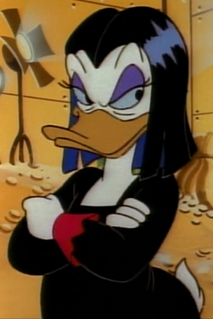
Magica De Spell is a cartoon character created in 1961 by Carl Barks for the Duck universe. An Italian sorceress, she constantly attempts to steal Scrooge McDuck's Number One Dime, which she believes will play a vital role in magically obtaining the same fabulous wealth of its owner.

Paige Matthews is a fictional character from the American television series Charmed, played by Rose McGowan from October 4, 2001, until May 21, 2006. The character was created by executive producer Brad Kern as a replacement for lead character Prue Halliwell, following the departure of actress Shannen Doherty. Paige is introduced into season four as the fiercely independent younger half-sister of the show's remaining female leads, Piper and Phoebe Halliwell. Like her sisters, Paige is a witch, and more specifically, a Charmed One—one of the most powerful witches of all time. Paige is introduced as the secret love child of the Halliwell sisters' mother Patty and her whitelighter Sam Wilder, making Paige both a witch and whitelighter. She was given up at birth and raised by her adoptive parents.

The Hellbound Heart is a horror novella by Clive Barker, first published in November 1986 by Dark Harvest in the third volume in its Night Visions anthology series. The story features a hedonist criminal acquiring a mystical puzzle box, the Lemarchand Configuration, which can be used to summon the Cenobites, demonic beings who do not distinguish between pain and pleasure. He escapes the Cenobites and, with help, resorts to murder to restore himself to full life. Later on, the puzzle box is found by another.

Leo Wyatt is a fictional character from The WB television series Charmed, portrayed by Brian Krause. A possible breakout character included in the writing initially as a love interest beginning in the first season that initially set Phoebe and Piper bickering and competing for his attention. He appeared as a guest star in seven episodes of the first season and six episodes of the second season. Midway through the second season, he joined the main cast and appeared in all but 11 episodes for the rest of the series' run. All together, he appeared in 145 episodes—the most of any male character in the series, and the most of any character who was not a Halliwell by birth.

Victoria Helen McCrae Duncan was a Scottish medium best known as the last person to be imprisoned under the Witchcraft Act 1735 for fraudulent claims. She was famous for producing ectoplasm which was proven to be made from cheesecloth.

Jadis is the main antagonist of The Lion, the Witch and the Wardrobe and The Magician's Nephew in C. S. Lewis's series, The Chronicles of Narnia. She is commonly referred to as the White Witch in The Lion, the Witch and the Wardrobe, as she is the Witch who froze Narnia in the Hundred Years Winter.
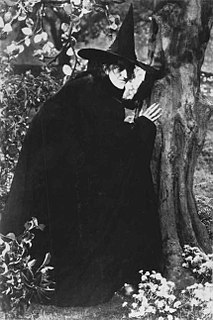
The Wicked Witch of the West is a fictional character who appears in the classic children's novel The Wonderful Wizard of Oz (1900), created by American author L. Frank Baum. In Baum's subsequent Oz novels, it is the Nome King who is the principal villain; the Wicked Witch of the West is rarely even referred to again after her death in the first book.

The Wicked Witch of the East is a fictional character created by American author L. Frank Baum. She is a crucial character but appears only briefly in Baum's classic children's series of Oz novels, most notably The Wonderful Wizard of Oz (1900).
The Cenobites are fictional extra-dimensional, seemingly demonic beings who appear in the works of Clive Barker. Introduced in Barker's 1986 novella The Hellbound Heart, they also appear in its semi-sequel novel The Scarlet Gospels, the Hellraiser films, and in Hellraiser comic books published (intermittently) between 1987 and 2017. In the novel Weaveworld, they are mentioned in passing as "The Surgeons". The Cenobites appear in prose stories authorized but not written by Clive Barker, such as the anthology Hellbound Hearts edited by Paul Kane and Marie O'Regan, the novella Hellraiser: The Toll, and the novel Sherlock Holmes and the Servants of Hell written by Paul Kane. Paradoxically, the definition of the word "cenobite" is a member of a religious group living together in a monastic community such as a nun or a monk.
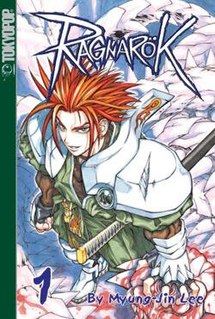
Ragnarok is a manhwa created by Lee Myung-jin and published by Daiwon C.I. in South Korea. There are currently 10 volumes in circulation, published in English in North America by Tokyopop from May 21, 2002 to April 6, 2004.
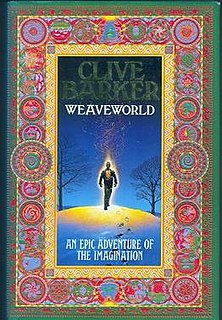
Weaveworld is a 1987 dark fantasy novel by Clive Barker. It is about a magical world that is hidden inside a tapestry, known as the Fugue, to safeguard it from both inquisitive humans and hostile supernatural foes. Two normal people become embroidered in the fate of the Fugue, attempting to save it from those who seek to destroy it. The book was nominated in 1988 for the World Fantasy Award for Best Novel.
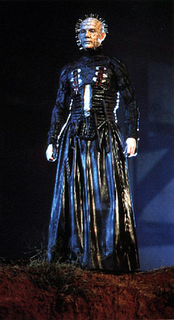
Pinhead, Lead Cenobite, or the Hell Priest, is the main antagonist of the Hellraiser franchise, first appearing as an unnamed figure in the 1986 Clive Barker novella The Hellbound Heart. When Clive Barker adapted the novella into the 1987 film Hellraiser, he referred to the character in early drafts as "the Priest" but the final film gave no name. The production and make-up crew nicknamed the character "Pinhead" and fans accepted the sobriquet, which was then used in press materials, tie-in media, and on-screen in some of the sequel films, although Clive Barker himself despises the nickname. In the 2011 comic book series Hellraiser published by Boom! Studios, Barker refers to the character as "the Priest." In that comic book series and the subsequent series Hellraiser: The Dark Watch, Cenobites refer to him as holding the title of "the Hell Priest" or "the Pontifex", making him "Hell's Pope." Nearly thirty years after The Hellbound Heart was published, Barker's 2015 novel The Scarlet Gospels cements the character's official title and rank is "the Hell Priest" and that he hates the nickname "Pinhead." In a later novella, Hellraiser: The Toll, it is said the character is also known to some as the Cold Man.
Serenity Rose is a comic created by Aaron Alexovich and published by Slave Labor Graphics. The story follows the life of Serenity Rose, as told by her through diary entries. All three volumes of Serenity Rose were published online first, starting in 2008, before being made available in print. In 2013, Alexovich started a Kickstarter to publish all volumes in a complete set, which reached full funding in November 2013. The comics in full are still available online.
The Stepford Cuckoos are a set of fictional mutants, psychically linked quintuplets appearing in American comic books published by Marvel Comics. The alphabetical order of the Cuckoos' first names corresponds with their ages, with Celeste being the firstborn and Sophie being the youngest. Originally calling themselves the Five-in-One, with the deaths of Esme and Sophie the remaining sisters are now known as the Three-in-One. They are students at the Xavier Institute for Higher Learning.

Sasami: Magical Girls Club is a magical girl anime which features the rather familiar likenesses of Sasami and other characters of the Tenchi Muyo! franchise, specifically those of Pretty Sammy. However, this series is not in the same continuity as the Pretty Sammy anime titles. The animation style is different and the story is set in an alternate universe.

Dorothy of Oz is a Japanese style manhwa by Son Hee-joon (손희준) originally published by Haksanpub and translated into English by UDON. The series contains five volumes to date; the first four of which have been translated into English.

The Sea Hag is a fictional character owned by King Features Syndicate. She is a tall, masculine looking witch featured in comics/cartoons as a nemesis to the character Popeye. The Sea Hag was created by Elzie Crisler Segar in 1929 as part of the Thimble Theatre comic strip.
The Books of Abarat are a series of young adult fantasy novels written and illustrated by English writer and visual artist Clive Barker. The series is intended to contain five books, of which three have so far been published. The series takes place on the Abarat, a fictional archipelago consisting of twenty-five islands, one for each hour of the day.

The Familiars is a series of children's fantasy books written by Adam Jay Epstein and Andrew Jacobson. The Familiars is also the title of the first book in the series, featuring familiars, magical animal companions to a wizard or witch. The series consists of 4 books, published between 2010 to 2013 by HarperCollins.
References
- ↑ "The World of Clive Barker". Archived from the original on 2007-09-27. Retrieved 2006-06-27.
- ↑ The Official Clive Barker Resource - Revelations - Barker on Weaveworld